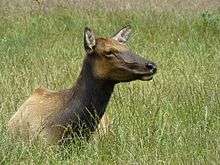Roosevelt elk
The Roosevelt elk (Cervus canadensis roosevelti), also known commonly as the Olympic elk and Roosevelt's wapiti, is the largest of the four surviving subspecies of elk (Cervus canadensis) in North America.[1] Its geographic range includes temperate rainforests of the Pacific Northwest, extending to parts of northern California. It was introduced to Alaska's Afognak, Kodiak, and Raspberry Islands in 1928.[2][3] The desire to protect the Roosevelt elk was one of the primary forces behind the establishment of the Mount Olympus National Monument in 1909 by President Theodore Roosevelt. Later in 1937 President Franklin D. Roosevelt visited the region and saw the elk named after his relative.[4] The following year he created Olympic National Park.
| Roosevelt Elk | |
|---|---|
 | |
| Male (bull) at Northwest Trek, Washington, US | |
 | |
| Female at Prairie Creek Redwoods State Park, California, US | |
| Scientific classification | |
| Kingdom: | Animalia |
| Phylum: | Chordata |
| Class: | Mammalia |
| Order: | Artiodactyla |
| Family: | Cervidae |
| Subfamily: | Cervinae |
| Genus: | Cervus |
| Species: | |
| Subspecies: | C. c. roosevelti |
| Trinomial name | |
| Cervus canadensis roosevelti Merriam, 1897 | |
Description
The Roosevelt elk grows to around 6–10 ft (1.8–3 m) in length and stands 2.5–5.6 ft (0.75–1.7 m)[5] tall at the withers.[3] Roosevelt elk bulls generally weigh between 700 and 1,100 lb (300–500 kg), while cows weigh 575–625 lb (260–285 kg).[1] Some mature bulls from Raspberry Island in Alaska have weighed nearly 1,300 lb (600 kg).[1]
Diet
From late spring to early fall, the Roosevelt elk feeds upon herbaceous plants, such as grasses and sedges.[3] During winter months, it feeds on woody plants, including highbush cranberry, elderberry, devil's club, and newly planted seedlings (Douglas-fir and western redcedar).[3] The Roosevelt elk is also known to eat blueberries, mushrooms, lichens, and salmonberries.[3]
Longevity
In the wild, the Roosevelt elk rarely lives beyond 12 to 15 years, but in captivity it has been known to live over 25 years.[3]
Reintroduction
This elk subspecies, Cervus canadensis roosevelti, was reintroduced to British Columbia's Sunshine Coast from Vancouver Island in 1986.[6]
See also
| Wikimedia Commons has media related to Cervus canadensis roosevelti. |
References
- Robb, Bob (January 2001). The Ultimate Guide to Elk Hunting. The Lyons Press. ISBN 1-58574-180-9.
- Nancy Gates, ed. (November 2006). The Alaska Almanac: Facts about Alaska 30th Anniversary Edition. Alaska Northwest Books. ISBN 0-88240-652-3.
- Rennick, Penny (November 1996). Mammals of Alaska. Alaska Geographic Society. ISBN 1-56661-034-6.
- Houston, Douglas; Jenkins, Kurt. "Roosevelt Elk Ecology". Retrieved 2007-12-28.
- Arsenault, Anthony Alan (2008). "Saskatchewan Elk (Cervus elaphus) Management Plan - Update", p.2: "1.1.2 - Physical Description", Fish and Wildlife Technical Report 2008-03, Saskatchewan Ministry of Environment, Fish, and Wildlife Branch
- http://coastalinletadventures.com/bc-roosevelt-elk-hunting-british-columbia-canada.htm
Further reading
- Merriam CH (1897). "Cervus roosevelti, a New Elk from the Olympics". Proceedings of the Biological Society of Washington 11: 271–275. (Cervus roosevelti, new species, "Roosevelt's Wapiti").